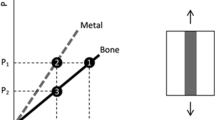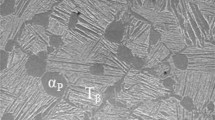We present the results of fatigue crack-growth tests for Ti–6Al–4V titanium alloy. Plane specimens 4 mm in thickness with a unilateral notch were tested. The analysis of crack growth was carried out for specimens without and after oxygenation process for 2 and 4 h. The fatigue crack growth rate was determined. It follows from the test results that the fatigue crack growth in the specimens without thermochemical treatment differs from the fatigue crack growth in the specimens after oxygenation. It has been also found that the applied surface treatment increases the fatigue life of the considered alloy.






Similar content being viewed by others
References
D. Rozumek and M. Hepner, “Influence of the microstructure of Ti–6Al–4V titanium alloy on the fatigue crack growth,” Mater. Eng., 2, 81–83 (2005).
D. Rozumek and E. Macha, “Fatigue crack growth in titanium and aluminum alloys under bending,” Mater. Science Forum, 567–568, 317–320 (2007).
D. Rozumek and M. Hepner, “Analysis of the fatigue crack growth in Ti–6Al–4V alloy without and after oxygenation,” Mater. Eng., 3, 154–156 (2008).
V. M Fedirko, A. T. Pichuhin, O. H. Luk’yanenko, and V. S. Onuferko, “Interstitial hardening of the surface of titanium alloys by vacuum heat treatment,” Mater. Sci., 41, No. 2, 208–216 (2005).
A. T. Pichuhin, V. M. Fedirko, O. H. Luk’yanenko, and V. S. Onuferko, “Endurance of VT1-0 titanium alloy subjected to solidsolution surface hardening,” Mater. Sci., No. 3, 418–422 (2005).
R. K. Nalla, J. P. Campbell, and R. O. Ritchie, “Mixed-mode, high-cycle fatigue-crack growth thresholds in Ti–6Al–4V: Role of small cracks,” Int. J. Fatigue, 23, 1047–1062 (2002).
W. Ziaja, J. Sieniawski, K. Kubiak, and M. Motyka, “Fatigue and microstructure of two-phase titanium alloys,” Mater. Eng., 22, 981–984 (2001).
P. C. Paris and F. Erdogan, “A critical analysis of crack propagation laws,” J. Basic Eng., Trans. ASME, 85, 528–534 (1960).
Author information
Authors and Affiliations
Corresponding author
Additional information
Published in Fizyko-Khimichna Mekhanika Materialiv, Vol. 47, No. 1, pp. 82–86, January–February, 2011.
Rights and permissions
About this article
Cite this article
Rozumek, D., Hepner, M. Influence of oxygenation time on crack growth in titanium alloy under cyclic bending. Mater Sci 47, 89–94 (2011). https://doi.org/10.1007/s11003-011-9372-y
Received:
Published:
Issue Date:
DOI: https://doi.org/10.1007/s11003-011-9372-y




